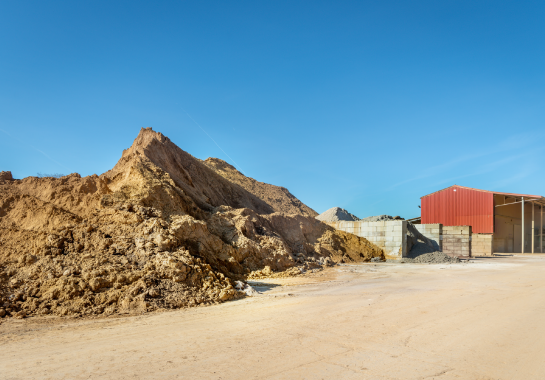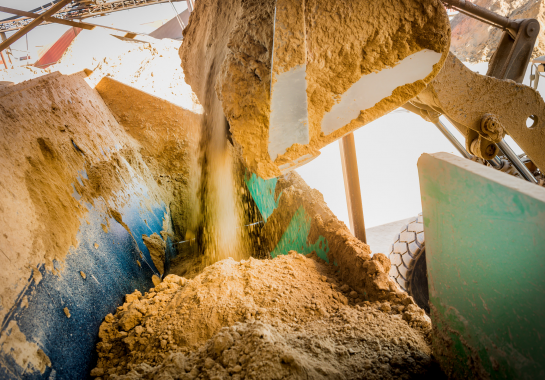27.07.2021
Löss, the brick industry's gold
Coal was the black gold that gave wealth to our nation. Löss-rich soil is gold to the brick industry. It is the primary raw material used in the production of our bricks.
Löss is a special type of loam that was deposited during the ice age, almost two million years ago, by the dominant northwesterly wind in the valleys of rivers such as the Waal, the Rhine and the Meuse. The loam layer is estimated to be 300 kilometres long and several kilometres wide. It stretches from Germany and Maastricht to South Limburg, all the way to Tienen, and ends in Kortemark in the province of West Flanders. Its thickness varies between six and fourteen metres from one location to the next.

The löss
It is no coincidence that the three largest brick factories in Belgium are located in the south of the Limburg province and in Dry Hesbaye. One of them is Nelissen, in Kesselt, near Lanaken. Dry löss is loose and crumbly. Essentially, it is an extremely fine powder. Löss is remarkably suitable for the hand-shaped facade brick that was pioneered nationally by Nelissen in 1930. The löss layer is six to eight metres thick on the plateau of Kesselt, which is where the Nelissen brick factory has been forming and baking bricks for 100 years. A unique feature is that the soil contains red, pink, yellow and grey loam. This allows Nelissen to manufacture red, yellow, pink and grey bricks. It gives the family business a competitive edge, both domestically and internationally.
Loam pits
For years, Nelissen was able to dig up loam on the Kesselt plateau, more specifically behind the factory buildings. The other brick factories in the Limburg province used to source their löss on site and in their direct vicinity as well. But the deposit of raw material for bricks is finite. Exports of bricks and domestic demand have been growing steadily in recent decades. Exports, in particular, have grown exponentially. As a result, the supply of löss in South Limburg and elsewhere dwindled. A shortage of the raw material for bricks loomed.

The loam bank
The Flemish government at the time also wanted to remedy the situation where each brick factory had its own loam pit. In order to combat fragmentation, the authorities formulated the aforementioned measure in a decree (i.e. Flemish law). In addition, the brick factories of Limburg – two are located in Kesselt, one in Kleine Spouwen (Bilzen) and one in Membruggen (Riemst) – urgently needed to secure loam reserves in order to keep up with the demand for bricks. For those reasons, and in order to secure the loam reserves, all four brick manufacturers in Limburg decided to join forces. They founded the Leembank (loam bank), a cooperative partnership. Gaston Nelissen was the first chair of the loam bank. An important step for tapping into new loam extraction zones is to obtain approval from the spatial execution plan for loam (the ‘RUP Leem’) in South Limburg. But brick factories are also required to restore pits to their original state once the loam has been extracted.
Löss is a special type of loam that was deposited during the ice age, almost two million years ago, by the dominant northwesterly wind in the valleys of rivers such as the Waal, the Rhine and the Meuse. The loam layer is estimated to be 300 kilometres long and several kilometres wide. It stretches from Germany and Maastricht to South Limburg, all the way to Tienen, and ends in Kortemark in the province of West Flanders. Its thickness varies between six and fourteen metres from one location to the next.

The löss
It is no coincidence that the three largest brick factories in Belgium are located in the south of the Limburg province and in Dry Hesbaye. One of them is Nelissen, in Kesselt, near Lanaken. Dry löss is loose and crumbly. Essentially, it is an extremely fine powder. Löss is remarkably suitable for the hand-shaped facade brick that was pioneered nationally by Nelissen in 1930. The löss layer is six to eight metres thick on the plateau of Kesselt, which is where the Nelissen brick factory has been forming and baking bricks for 100 years. A unique feature is that the soil contains red, pink, yellow and grey loam. This allows Nelissen to manufacture red, yellow, pink and grey bricks. It gives the family business a competitive edge, both domestically and internationally.
Loam pits
For years, Nelissen was able to dig up loam on the Kesselt plateau, more specifically behind the factory buildings. The other brick factories in the Limburg province used to source their löss on site and in their direct vicinity as well. But the deposit of raw material for bricks is finite. Exports of bricks and domestic demand have been growing steadily in recent decades. Exports, in particular, have grown exponentially. As a result, the supply of löss in South Limburg and elsewhere dwindled. A shortage of the raw material for bricks loomed.

The loam bank
The Flemish government at the time also wanted to remedy the situation where each brick factory had its own loam pit. In order to combat fragmentation, the authorities formulated the aforementioned measure in a decree (i.e. Flemish law). In addition, the brick factories of Limburg – two are located in Kesselt, one in Kleine Spouwen (Bilzen) and one in Membruggen (Riemst) – urgently needed to secure loam reserves in order to keep up with the demand for bricks. For those reasons, and in order to secure the loam reserves, all four brick manufacturers in Limburg decided to join forces. They founded the Leembank (loam bank), a cooperative partnership. Gaston Nelissen was the first chair of the loam bank. An important step for tapping into new loam extraction zones is to obtain approval from the spatial execution plan for loam (the ‘RUP Leem’) in South Limburg. But brick factories are also required to restore pits to their original state once the loam has been extracted.
